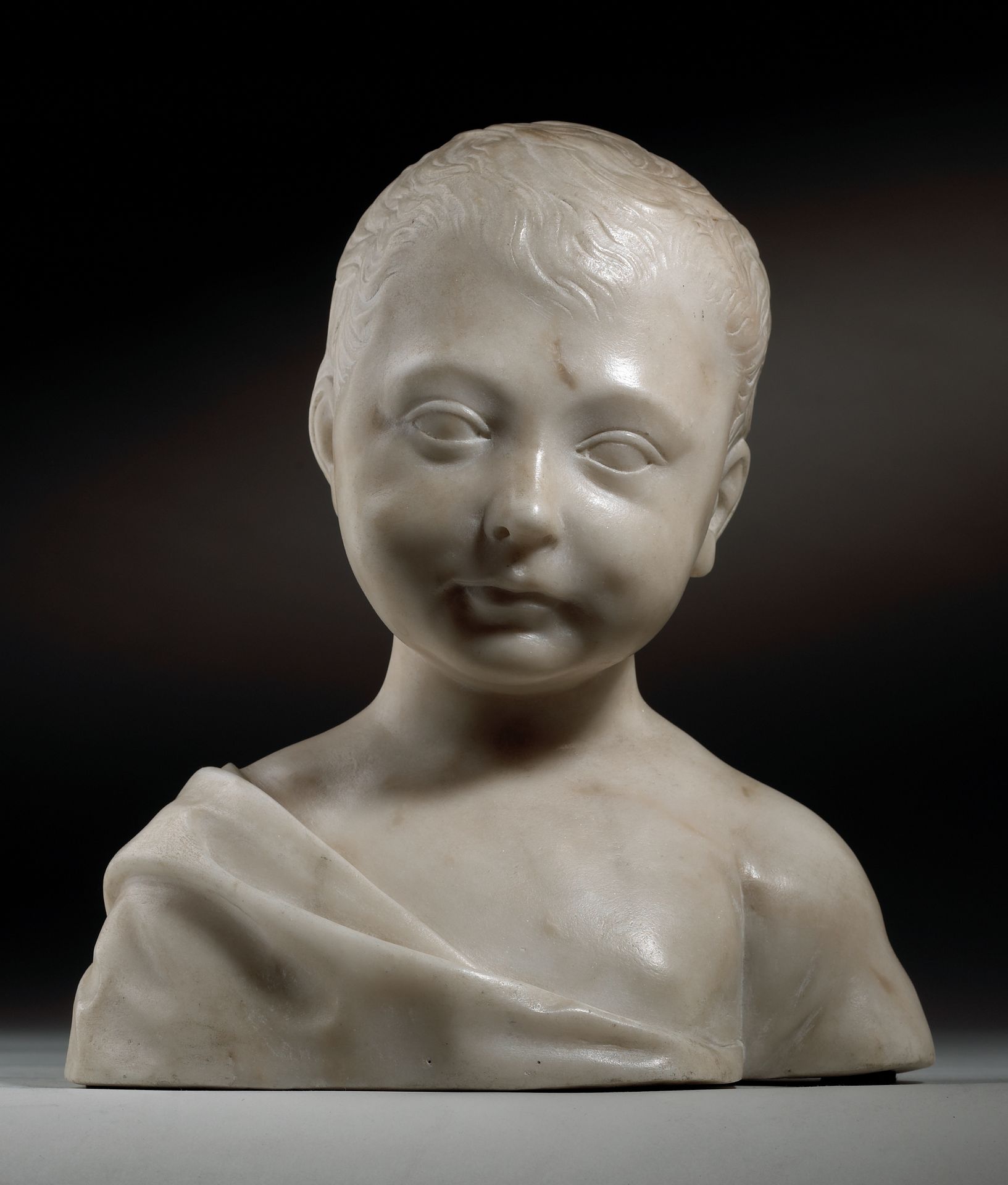Description
DESIDERIO DA SETTIGANO (1428-1464), circle of BUST OF THE CHILD CHRIST Italy, Florence, mid 15th century Marble 25 x 28 cm This bust of a young child refers to the representations of holy children in Florentine homes during the Renaissance, in order to provide children with models of piety to follow (cf.Paolozzi Strozzi, op.cit., p.119). Presented from the front, the head slightly tilted to the left and forward. The face is characterized by a rounded oval, the cheeks swollen, the features of great finesse. The hairstyle is also very fine, with furrows dug into the surface but with a very natural look. The bust is half bare, the right shoulder is covered by a drape. This bust is closely related to two sculpted marble busts by Desiderio da Settignano (1430-1464), which are in the National Gallery in Washington (fig. 1-2) and are sometimes considered to represent the Christ Child. Other comparable busts of the Infant Jesus and St. John were carved by Desiderio's contemporaries, Antonio Rossellino and Mino da Fiesole. CIRCLE OF DESIDERIO DA SETTIGNANO, A MARBLE BUST OF THE CHRIST CHILD, MID 15TH CENTURY, FLORENCE, ITALY Dim. 25 x 28 cm This bust of a young child refers to the representations of holy children in the Florentine Renaissance houses, in order to provide to children models of piety to follow (cf. Paolozzi Strozzi, op.cit., p.119). Facing front, the head slightly angled to the left and forward. The face is characterized by a rounded oval, the cheeks swollen, the features of great finesse. The very fine hairstyle is rendered by thin carved locks on the surface of the marble, yet with great realism. The bust is half naked, the right shoulder is covered. This bust is to be related to two sculpted marble busts by Desiderio da Settignano (1430-1464), and kept at the National Gallery in Washington (fig. 1-2) and who are sometimes considered to represent the Christ Child. Other comparable busts of the Christ Child and Saint John were sculpted by the contemporaries of Desiderio, Antonio Rossellino and Mino da Fiesole.
19
DESIDERIO DA SETTIGANO (1428-1464), circle of BUST OF THE CHILD CHRIST Italy, Florence, mid 15th century Marble 25 x 28 cm This bust of a young child refers to the representations of holy children in Florentine homes during the Renaissance, in order to provide children with models of piety to follow (cf.Paolozzi Strozzi, op.cit., p.119). Presented from the front, the head slightly tilted to the left and forward. The face is characterized by a rounded oval, the cheeks swollen, the features of great finesse. The hairstyle is also very fine, with furrows dug into the surface but with a very natural look. The bust is half bare, the right shoulder is covered by a drape. This bust is closely related to two sculpted marble busts by Desiderio da Settignano (1430-1464), which are in the National Gallery in Washington (fig. 1-2) and are sometimes considered to represent the Christ Child. Other comparable busts of the Infant Jesus and St. John were carved by Desiderio's contemporaries, Antonio Rossellino and Mino da Fiesole. CIRCLE OF DESIDERIO DA SETTIGNANO, A MARBLE BUST OF THE CHRIST CHILD, MID 15TH CENTURY, FLORENCE, ITALY Dim. 25 x 28 cm This bust of a young child refers to the representations of holy children in the Florentine Renaissance houses, in order to provide to children models of piety to follow (cf. Paolozzi Strozzi, op.cit., p.119). Facing front, the head slightly angled to the left and forward. The face is characterized by a rounded oval, the cheeks swollen, the features of great finesse. The very fine hairstyle is rendered by thin carved locks on the surface of the marble, yet with great realism. The bust is half naked, the right shoulder is covered. This bust is to be related to two sculpted marble busts by Desiderio da Settignano (1430-1464), and kept at the National Gallery in Washington (fig. 1-2) and who are sometimes considered to represent the Christ Child. Other comparable busts of the Christ Child and Saint John were sculpted by the contemporaries of Desiderio, Antonio Rossellino and Mino da Fiesole.
